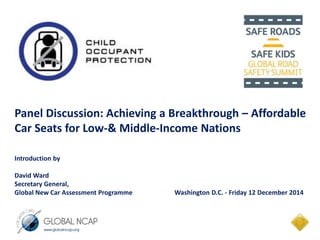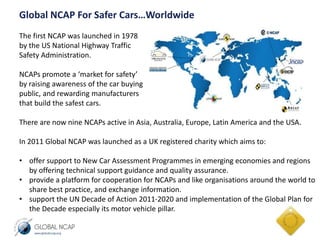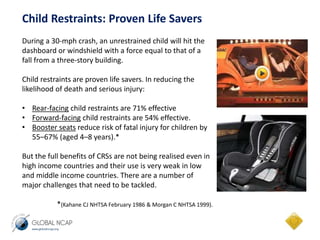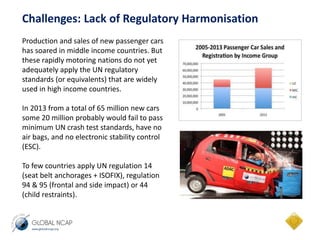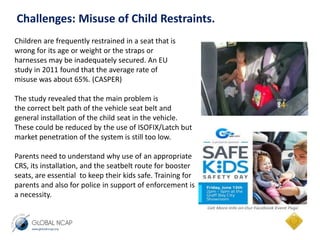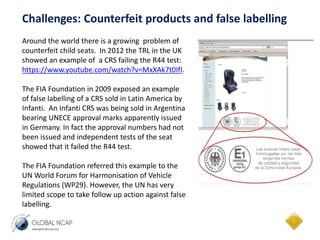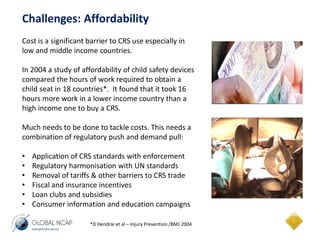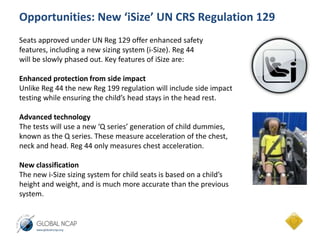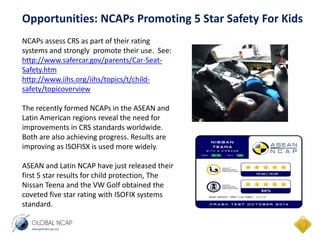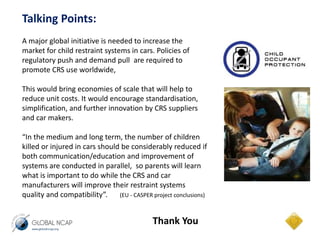2014 safe-kids-summit
- 1. Panel Discussion: Achieving a Breakthrough – Affordable Car Seats for Low-& Middle-Income Nations Introduction by David Ward Secretary General, Global New Car Assessment Programme Washington D.C. - Friday 12 December 2014
- 2. Global NCAP For Safer Cars…Worldwide The first NCAP was launched in 1978 by the US National Highway Traffic Safety Administration. NCAPs promote a ‘market for safety’ by raising awareness of the car buying public, and rewarding manufacturers that build the safest cars. There are now nine NCAPs active in Asia, Australia, Europe, Latin America and the USA. In 2011 Global NCAP was launched as a UK registered charity which aims to: • offer support to New Car Assessment Programmes in emerging economies and regions by offering technical support guidance and quality assurance. • provide a platform for cooperation for NCAPs and like organisations around the world to share best practice, and exchange information. • support the UN Decade of Action 2011-2020 and implementation of the Global Plan for the Decade especially its motor vehicle pillar.
- 3. Child Restraints: Proven Life Savers During a 30-mph crash, an unrestrained child will hit the dashboard or windshield with a force equal to that of a fall from a three-story building. Child restraints are proven life savers. In reducing the likelihood of death and serious injury: • Rear-facing child restraints are 71% effective • Forward-facing child restraints are 54% effective. • Booster seats reduce risk of fatal injury for children by 55–67% (aged 4–8 years).* But the full benefits of CRSs are not being realised even in high income countries and their use is very weak in low and middle income countries. There are a number of major challenges that need to be tackled. *(Kahane CJ NHTSA February 1986 & Morgan C NHTSA 1999).
- 4. Challenges: Lack of Regulatory Harmonisation Production and sales of new passenger cars has soared in middle income countries. But these rapidly motoring nations do not yet adequately apply the UN regulatory standards (or equivalents) that are widely used in high income countries. In 2013 from a total of 65 million new cars some 20 million probably would fail to pass minimum UN crash test standards, have no air bags, and no electronic stability control (ESC). To few countries apply UN regulation 14 (seat belt anchorages + ISOFIX), regulation 94 & 95 (frontal and side impact) or 44 (child restraints).
- 5. Challenges: Misuse of Child Restraints. Children are frequently restrained in a seat that is wrong for its age or weight or the straps or harnesses may be inadequately secured. An EU study in 2011 found that the average rate of misuse was about 65%. (CASPER) The study revealed that the main problem is the correct belt path of the vehicle seat belt and general installation of the child seat in the vehicle. These could be reduced by the use of ISOFIX/Latch but market penetration of the system is still too low. Parents need to understand why use of an appropriate CRS, its installation, and the seatbelt route for booster seats, are essential to keep their kids safe. Training for parents and also for police in support of enforcement is a necessity.
- 6. Challenges: Counterfeit products and false labelling Around the world there is a growing problem of counterfeit child seats. In 2012 the TRL in the UK showed an example of a CRS failing the R44 test: https://www.youtube.com/watch?v=MxXAk7t0IfI. The FIA Foundation in 2009 exposed an example of false labelling of a CRS sold in Latin America by Infanti. An Infanti CRS was being sold in Argentina bearing UNECE approval marks apparently issued in Germany. In fact the approval numbers had not been issued and independent tests of the seat showed that it failed the R44 test. The FIA Foundation referred this example to the UN World Forum for Harmonisation of Vehicle Regulations (WP29). However, the UN has very limited scope to take follow up action against false labelling.
- 7. Challenges: Affordability Cost is a significant barrier to CRS use especially in low and middle income countries. In 2004 a study of affordability of child safety devices compared the hours of work required to obtain a child seat in 18 countries*. It found that it took 16 hours more work in a lower income country than a high income one to buy a CRS. Much needs to be done to tackle costs. This needs a combination of regulatory push and demand pull: • Application of CRS standards with enforcement • Regulatory harmonisation with UN standards • Removal of tariffs & other barriers to CRS trade • Fiscal and insurance incentives • Loan clubs and subsidies • Consumer information and education campaigns *D Hendrie et al – Injury Prevention /BMJ 2004
- 8. Opportunities: New ‘iSize’ UN CRS Regulation 129 Seats approved under UN Reg 129 offer enhanced safety features, including a new sizing system (i-Size). Reg 44 will be slowly phased out. Key features of iSize are: Enhanced protection from side impact Unlike Reg 44 the new Reg 199 regulation will include side impact testing while ensuring the child’s head stays in the head rest. Advanced technology The tests will use a new ‘Q series’ generation of child dummies, known as the Q series. These measure acceleration of the chest, neck and head. Reg 44 only measures chest acceleration. New classification The new i-Size sizing system for child seats is based on a child’s height and weight, and is much more accurate than the previous system.
- 9. Opportunities: NCAPs Promoting 5 Star Safety For Kids NCAPs assess CRS as part of their rating systems and strongly promote their use. See: http://www.safercar.gov/parents/Car-Seat- Safety.htm http://www.iihs.org/iihs/topics/t/child-safety/ topicoverview The recently formed NCAPs in the ASEAN and Latin American regions reveal the need for improvements in CRS standards worldwide. Both are also achieving progress. Results are improving as ISOFISX is used more widely. ASEAN and Latin NCAP have just released their first 5 star results for child protection, The Nissan Teena and the VW Golf obtained the coveted five star rating with ISOFIX systems standard.
- 10. Talking Points: A major global initiative is needed to increase the market for child restraint systems in cars. Policies of regulatory push and demand pull are required to promote CRS use worldwide, This would bring economies of scale that will help to reduce unit costs. It would encourage standardisation, simplification, and further innovation by CRS suppliers and car makers. “In the medium and long term, the number of children killed or injured in cars should be considerably reduced if both communication/education and improvement of systems are conducted in parallel, so parents will learn what is important to do while the CRS and car manufacturers will improve their restraint systems quality and compatibility”. (EU - CASPER project conclusions) Thank You

